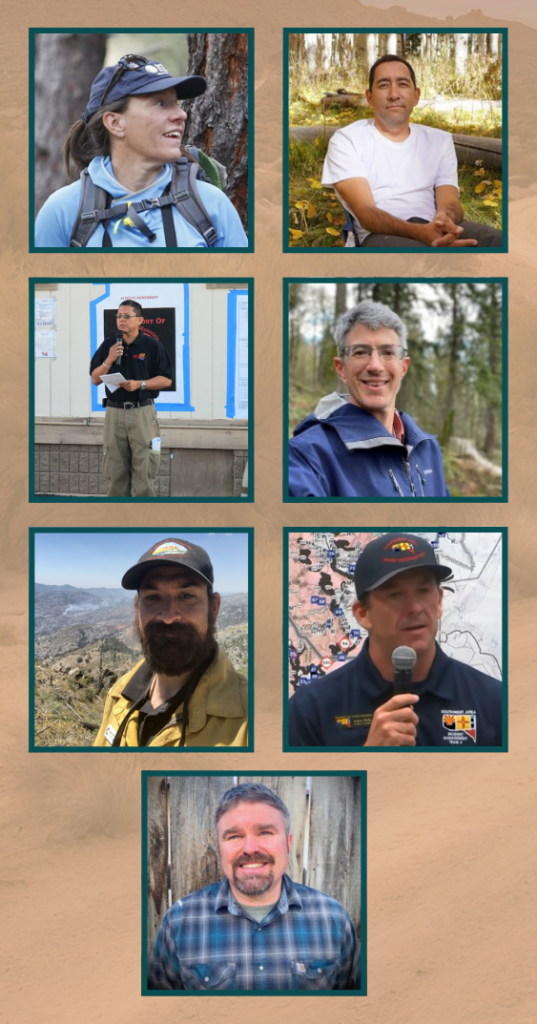Plenary Sessions
Opening Plenary Session

Tuesday, Nov 19 8:30am to 10:30am
Welcome and Opening Blessing
- Governor Milton Herrera, Pueblo of Tesuque
- Laura McCarthy, State Forester, New Mexico Forestry Division
- Michiko Martin, Regional Forester, USFS Region 3
Presentation by Dick Cooke, Director of Forestry, Village of Ruidoso
- Fuels mitigation effects on the South Fork Fire in Ruidoso, NM: This presentation showcases the positive effects of treating green fuels to mitigate the effects of wildfire damage during a wildfire under extreme fire weather conditions.
Film premiere of the Restoration of Santa Clara Canyon
The Past, Present and Future of Beneficial Fire

Wednesday, Nov 20 8:30am to 10:30am
This plenary will start with talk show-style interviews of the panelists followed by Q&A from the audience. The audience will then have time for small facilitated group discussion about the future of beneficial fire in the Southwest.
Moderators
- Shaula Hedwall, Fish and Wildlife Biologist, US Fish and Wildlife Service
- Jose Iniguez, Research Ecologist, Rocky Mountain Research Station, USDA Forest Service
Panelists
- Leon Ben, Jr., Superintendent, BIA Fort Apache Agency
- Zander Evans, Executive Director, Forest Stewards Guild
- Stephen Fillmore, Region 5 Fuels Operations Specialist, USDA Forest Service
- Aaron Hulburd, Fire Chief, Prescott National Forest
- Jeremy Marshall, Rio Chama CFLRP Team Leader, USDA Forest Service
Beneficial fire has been used since time immemorial by Indigenous land stewards. Beneficial fire was removed from many ecosystems, but its return is crucial for resilient communities and ecosystems. Currently, beneficial fire can be in the form of cultural burning, prescribed fire, and managed wildfire. In the Southwest, fire management has changed drastically over the last 40 years. In 2009, new policy guidance provided greater flexibility to use managed wildfires and although the number of managed fires increased, the total area generally remained the same. Similarly, after 2009, managed fires still burned primarily within or close to wilderness areas and away from WUI. In recent years however, the majority of the area burned in the Southwest has been a result of beneficial fires that typically burn in the shoulder season and at low severity. In order to minimize large severe wildfires and restore resilient forests, beneficial fire will need to continue being an important tool despite challenges in terms of smoke, infrastructure and agency support.
The Past, Present and Future of Workforce Development and Education

Thursday, Nov 21 8:30am to 10:30am
This plenary will feature short talks from the panelists followed by Q&A from the audience. The audience will then have time for small facilitated group discussion about the future of workforce development and education.
Moderator
- Eytan Krasilovsky, Deputy Director, Forest Stewards Guild
Panelists
- Phil Graeve, Deputy Director, Prescribed Fire Training Center
- Heather Heward, Senior Fire Ecology & Management Instructor, Department of Forest, Rangeland and Fire Sciences, University of Idaho
- Tami Parkinson, Retired, Wildland Fire Management Research Development and Application Group, USDA Forest Service
- Chas Robles, Executive Director, Ancestral Lands Conservation Corps
- Andi Thode, Professor Fire Ecology and Management, School of Forestry, Northern Arizona University
The federal wildland firefighting workforce comprises approximately 11,300 firefighters in the Forest Service and 5,750 employed by four Department of the Interior agencies. Notably, half of this workforce is seasonal, with employment limited to a maximum of six months. The recent national Wildfire Commission report underscored that “the scope and size of the existing workforce is not sufficient for the scale of wildfire risk reduction, response, and post-fire recovery work required now, let alone into the future… Federal investment is urgently needed to create new and expanded workforce capacity that is focused on, and tailored to, mitigation, planning, and post-fire response and recovery for communities and landscapes.”
A report indicated that 20% of USFS permanent firefighter positions are vacant, with recruitment and retention challenges exacerbated in areas with limited labor pools or non-competitive wages. Many of the unfilled positions are senior fireline leadership roles or those requiring higher qualifications.
In addition to workforce size, wildland fire managers confront complex decisions with ecological, social, and political implications. Positions such as fuels specialists, fire ecologists, and fire planners need not only NWCG qualifications but also a deep understanding of the science behind fuels treatments and wildland fire management. Acquiring and maintaining this combination of skills and knowledge is challenging. Changes in job series codes—from 462, 401, to 456—have altered educational requirements for wildland firefighters over time, complicating promotional tracks, access to education, and contributing to pay inequities.
Despite these challenges, progress has been made. Growth in both academic and on-the-job training has improved wildfire management and resilience planning. For instance, the JFSP Knowledge Exchanges have enhanced fire knowledge nationwide for over a decade. Continued investment and innovation in workforce development will be crucial to addressing the evolving demands of wildfire management and ensuring long-term community and environmental resilience.